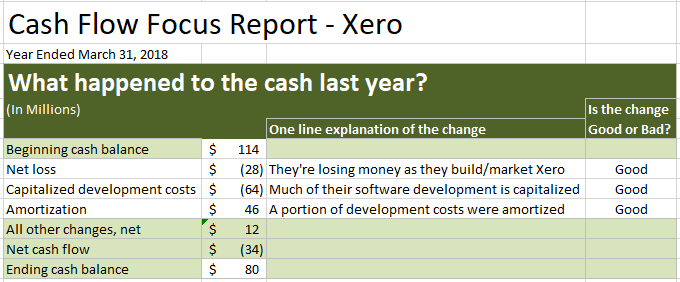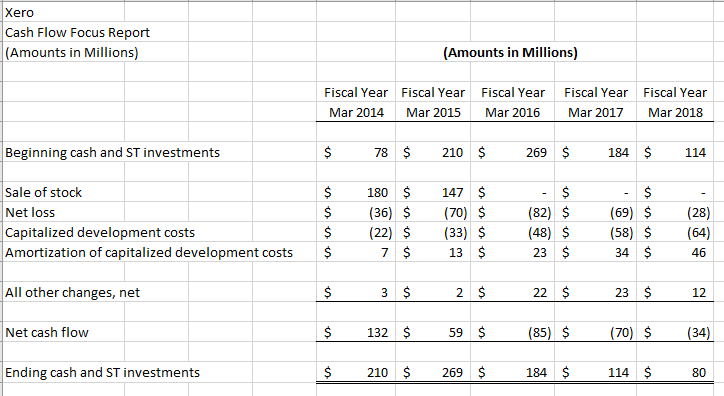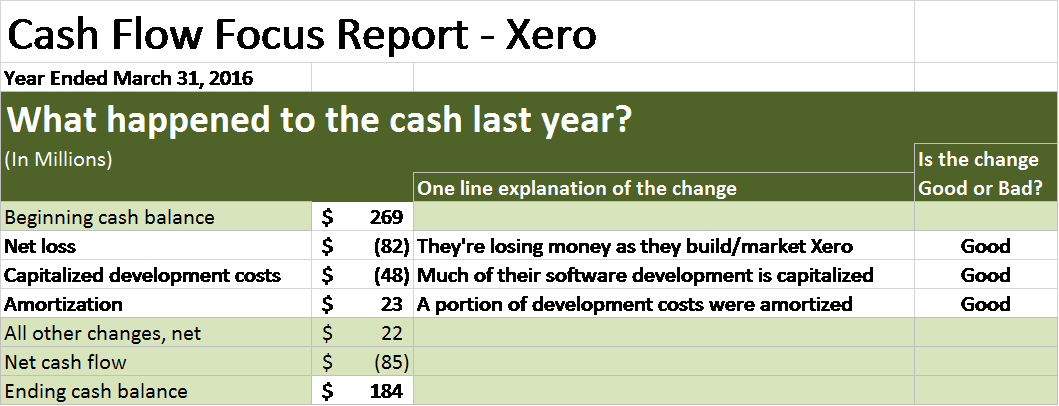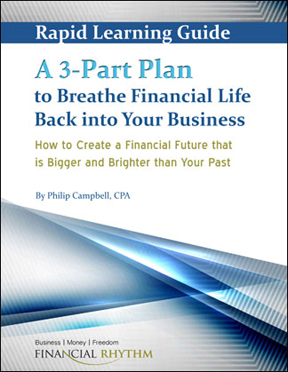I enjoy looking in on the cash flow of Xero from time to time to see how the company is doing financially. Xero is a cloud-based accounting and business software company. They are a public company on the Australian Securities Exchange.
For the year ended March 2018, Xero lost $28 million and their cash went down by $34 million. My favorite approach to looking at the big picture financial performance of a company is to “xero” in on the cash. I use the Cash Flow Focus Report to do that. Here it is for the year ended March 2018:
The Three Largest Drivers of Cash Flow
Let’s look at each of the three largest drivers of Xero’s cash flow for the year.
Net loss – The company lost $28 million on $407 million in revenues. That’s a big percentage of revenues. In deciding to label this either good or bad, I would normally look at the budget or the forecast to see if it is line with expectations and strategy. In this case, I labeled it as good because losing money (at least for now) is part of their strategic plan to grow. And they are losing less money now than in recent years.
Capitalized development costs – A large portion of the money Xero is spending on the actual creation of their cloud-based software is being capitalized because it benefits future periods. In FY 2018, they put $64 million of those costs on the balance sheet and will amortize (expense) it over time. I labeled it as good because there is very little chance the dollar amount is a surprise to management. 😊
Amortization – $46 million of previously capitalized development costs were amortized (expensed) during the year. I labeled it as good since the costs must be amortized. It is somewhat interesting to note that the amortization charge is much smaller than the amount capitalized for the year indicating there is still a lot of development going on (and that amortization expense will go up in future years).
Other Financial Highlights
- Revenues for the year were $406.6 million compared to $295.4 in the prior year. $31.8 million of current year revenue was in North America.
- They have 1.4 million subscribers compared to 1.0 million in the prior year. 132,000 of the subscribers in the current year are in North America.
- They have 2,021 employees compared to 1,721 in the prior year.
- They have raised a total of $380 million (or so) since their founding in 2006.
- Their year-end cash balance was $80 million.
The 2-Minute Summary
Once I create a Cash Flow Focus Report, my next step is to articulate the “2-minute summary.” The 2-Minute Summary is a short, big picture review of the company’s cash flow for the period. It answers the question “What happened to the cash last year?” Here is how I would summarize Xero’s cash flow for 2018:
Cash went down by $34 million during the year. The net loss was $28 million which was much lower than the losses in prior years. Capitalized development costs were a record $64 million as the company continues to develop their software offerings for small businesses. The amortization of previously capitalized development costs was $46 million. The cash balance at the end of the year was $80 million.
Five Year Cash Flow Summary
I also like to look at a summary view of cash flow over the last five years or so to learn about the financial history of the company. This is a great way to see a financial overview from a big picture, “what’s going on with the cash”, perspective. Here is a summary view of the primary drivers of cash flow over the last five years:
Here are some observations about Xero’s cash flow over the last five years:
- In 2014 and 2015 they raised a ton of cash from equity investors. They have not raised any money since 2015.
- The net loss has been coming down over the last two years. The big question is whether this trend will continue in the coming years.
- The increase in capitalized development costs indicates they are going even faster to add to their suite of software tools for businesses (see my note below about the Xero brand refresh). It has increased each year since 2014.
- Amortization of capitalized development costs is going up as the spending on development costs go up. This is the amortization over 3 to 5 years of the accumulated development costs that have been previously capitalized. This number will be going up in the future (because the spending is going up).
Future Cash Flow
Now we have answered the first key question: “What happened to the cash”? The next question is “What’s about to happen to the cash”? (Those are the two questions you need to be able to answer in your business as well.)
Here is a quote from the Founder, Rod Drury, in the 2018 annual report:
“As we signaled at our half year result, Xero’s organic growth will soon be funded from our own free cash flows – the next stage of our journey will be one in which we are self-funding and focused on realizing the long-term opportunities that we are well positioned to secure.”
It does not sound like they plan to sell more stock in the future. But with the growing expenditures on software development costs, possible acquisitions of other software companies, continuing losses, and a shrinking cash balance, it will be interesting to see if Xero will be forced to raise additional money (either equity or debt) in the years to come.
A Brand Refresh at Xero
The Xero tagline used to be “Beautiful Accounting Software.” Here is a quote for the Founder about how they are refreshing the brand and the tagline:
“Xero is evolving from a back-office accounting platform to a small business platform. There is significant potential in terms of products, services and solutions that we are able to create and extend to small businesses to help them more effectively manage their businesses. Likewise, we have an enormous opportunity to supply more services and value to our Xero partners.
Reflecting this evolution to a small business platform, and consistent with beginning the next chapter, customers will soon see a refreshed Xero brand position in the market. This will be ‘beautiful business’ – a recognition of the role small businesses, our partners and Xero play in building a better world. It will also portray Xero’s commitment to continue providing a powerful business platform that makes doing business easier.”
We’ll see what happens when they provide their annual report for the year ended March 2019. I’ll update the Cash Flow Focus Report and share it with you.
Additional Resources
Here are some links to additional resources and examples about how to use the Cash Flow Focus Report to help you better understand and manage your cash flow.
Using the Cash Flow Focus Report for Xero’s 2016 cash flow.
Using the Cash Flow Focus Report for Xero’s 2014 cash flow.
Using the Cash Flow Focus Report for Scott’s Liquid Gold cash flow.
Step-by-step process for using the Cash Flow Focus Report in your business.
Understanding Your Cash Flow – In Less Than 10 Minutes
I created a short, video-based, online course to help you implement the Cash Flow Focus Report in your business. The promise of the course is to show you how to understand your cash flow in less than 10 minutes a month.
The cost is about the same as a small book. And it comes with my no questions asked, 100% money-back guarantee. If you don’t LOVE it, I’ll refund your purchase super-fast.
Philip Campbell is an experienced financial consultant and author of the book A Quick Start Guide to Financial Forecasting: Discover the Secret to Driving Growth, Profitability, and Cash Flow and the book Never Run Out of Cash: The 10 Cash Flow Rules You Can’t Afford to Ignore. He is also the author of a number of online courses including Understanding Your Cash Flow – In Less Than 10 Minutes. His books, articles, blog and online courses provide an easy-to-understand, step-by-step guide for entrepreneurs and business owners who want to create financial health, wealth, and freedom in business.
Philip’s 30 year career includes the acquisition or sale of 33 companies (and counting) and an IPO on the New York Stock Exchange.
This book provides a straightforward, easy-to-understand guide to one of the most powerful financial tools in business: a reliable financial forecast. It will transform the financial future of your company and help you make better, faster, smarter financial decisions.
Too many entrepreneurs and CEOs today are feeling more like passengers than drivers in their business. They’re staring at their rearview mirror as they bounce along in the passenger seat. Their company is careening along on the highway of business as they wonder and worry about where their business might end up financially.
A reliable financial forecast solves this problem by providing a clear view through the financial windshield of your business. It creates the visibility and clarity you need to drive your company toward a bigger and brighter financial future.
What if you had answers to questions like:
What’s about to happen to my profitability and cash flow?
How much cash can we distribute to the owners of the business?
How long will it take to pay off our debt?
What will our taxable income be this year?
A reliable financial forecast puts the answers to these questions at your fingertips. It helps you take control of your profitability and cash flow because it gives you answers to the most important financial questions you have to deal with every day.
Put yourself in the driver’s seat of your business by tapping into the unique and exciting benefits that financial forecasting can unlock for you.
Buy the Kindle version at Amazon.
Buy the book at Barnes & Noble.
If you already own the book, the free tools and downloads are waiting for you. Click here to access the financial spreadsheets, examples, rapid learning guides, and more.






